|
MAKING A PREMIER
Quite a settlement had
been formed along the Penetang' Road north of Barrie ten years before
settlement began even at the southern end of Innisfil, the township
forming the west shore of the lower end of Lake Simcoe. There were two
reasons for this. The first was due to comparative ease of
communication; the second, to market facilities. The old military
highway between Lake Ontario and Georgian Bay followed the line of Yonge
Street to Holland Landing, thence up Lake Simcoe to Kempenfeldt Bay and
then again overland to Penetanguishene. Hence it was a comparatively
easy matter to reach the country about Crown Hill, Dalston, and
Craighurst several years before the opening of the lower section of the
Penetang' Road between Holland Landing and Barrie provided for the
settlement of Innisfil.
The principal reason for
the earlier settlement in the more northerly section was based on market
considerations. The naval and military post, first established at
Nottawasaga, was transferred from that point to Penetanguishene in 1818
and somewhat later the post at Drummond Island was added. The presence
of a military and naval station thus made this northern port a centre of
commercial activity. It was a centre of Indian trade as well, "and there
was," as a grandson of one of the Crown Hill pioneers expressed it, "a
general belief that Penetang' was destined to be the metropolis of Upper
Canada."
The Penetang' dream of
the pioneers has not come true, but Crown Hill, which owes its origin to
the existence of the old naval station on Georgian Bay, has to its
credit something that cannot be claimed for any other rural section of
Ontario. It gave to the province the first head of the provincial
Department of Agriculture and in the son of that head the first farmer
premier of the province. The Drurys, Partridges, and Hicklings were
among the first to come in along the upper end of the Penetang' Road,
settling in 1819 near where Crown Hill now is; the Lucks, another large
connection, corning in a year later. The Drurys came from England; the
Lucks and Partridges, from Albany, N.Y.
"When Grandfather
Partridge moved in, lie brought his wife and two children with him as
far as Holland Landing," one of the third generation told me. "From
Holland Landing he walked alone all the way to Penetang,' his route
around the west side of Lake Simcoe to Kempenfeldt Bay being over a
blazed trail. After satisfying himself as to the future of Penetang' he
started to walk back, digging into the soil at intervals by the way in
order to learn its quality. He walked twenty-five miles before finding
what suited him, and finally located near Crown Hill, taking up four
hundred acres in all, half on the Oro and half on the Vespra side.
Having built a log cabin he went back to Holland Landing for his wife
and children and began family life in the new home in the bush in
October. Afterwards, when the road was fully opened out, lie found that
his cabin was almost in the middle of the King's highway. Hardships m
You can judge of general conditions at that time when I relate one fact
told me by my grandfather. He packed his first grist on his back from
Crown Hill to the east end of what is now Barrie and then paddled it in
a dugout the rest of the way, twenty miles, to the old Red Mill at
Holland .Landing."
One hundred years ago
Penetang' Road was an Indian highway, as well as a military road, the
Indians traversing it on their way to Toronto for the annual
distribution of presents by the Government. On one occasion, as narrated
by Hunter in his "History of Simcoe County," a number of drunken red men
called at the home of James White, while his wife was alone in the
house, and were promptly chased out again by Mrs. White, who had armed
herself with a pair of tongs.
Adventures with bears
there were, too, one of these being narrated by Hunter. Gideon
Richardson, to protect his pigs against the black marauders, built a pen
opposite the door of his cabin and kept a log fire burning at night
beyond the pen. One night, after a rain, the fire could not be lighted
and bruin took advantage of the situation to raid the pen. In the course
of the attack one pig was hurled through the door of the cabin into the
midst of the sleeping inmates. There was no more sleep for the family
that night.
One of the first cares of
the settlement about Crown Hill was to make provision for the
educ'a.tion of the children, and some time before 1837 a voluntary
school was established, with William Crae as the first teacher. Crown
Hill pioneers were also among the first to take advantage of the
Education Acts of 1841-43, under which an annual provincial
appropriation of twenty thousand pounds was made to assist in the work
of primary education. In fact, a school was established on the Vespra
side as early as 1842 with Edward Luck as the first teacher, a position
he filled for twenty-two years. The selection of Mr. Luck was peculiarly
fitting in at least one respect as, from first to last, no fewer than
fifteen of his own children passed under the rod in that same school.
"The building was, of
course, of log," said i grandson of one of the pioneers, "and the
benches were of plank with home-made legs supporting them. In the
beginning the building was used for a church as well as a school, and
there was a pulpit in one corner for the church services. Pastor Ardagh
and Canon Morgan were the first to officiate. Marriage services were
performed there, and on such occasions the benches were moved back and
boys and girls lined up in front of the pulpit as witnesses."
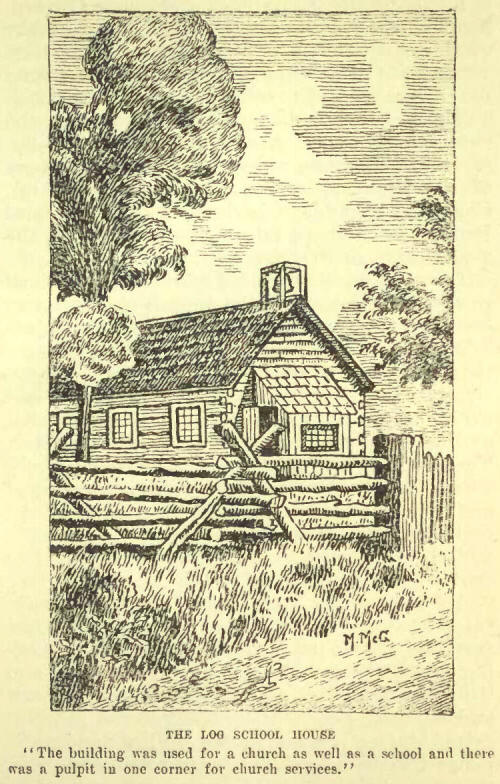
The old minute book of
the section, dating back to 1844, is still in existence. This records
that Thomas Ambler, George Caldwell, and Jonathan Sissons, the latter
grandfather of Professor Sissons of Victoria College, were the trustees
in 1845. The record further shows that the salary paid Mr. Luck in that
year was twenty-five pounds currency "over and above Government
allowance and taxes." In order to make tip the amount required to keep
the school going, sixteen of the settlers agreed to pay one pound for
each child sent to school by them, the largest single contributor being
William Larkin, who paid four pounds. Among the other contributors were
Jonathan Sissons, Thomas Mairs (one of the first. importers of "Durham"
cattle), Charles Partridge, Charles Hickling, Thomas Drury, and Richard
Drury, the latter being the grandfather of Premier E. C. Drury.
The amounts contributed
by these enlightened pioneers for the education of their children may
seem small to those of the present generation, but they were in reality
relatively larger than similar contributions to-day. Incomes were small.
By that time local production had exceeded the requirements of the local
market at Penetang' and an outlet had to be found at Toronto, seventy
miles away over rough roads. The prices obtained for farm produce in
general at the provincial capital may be gauged by the fact that oats
teamed there, reaped with a cradle and threshed with a flail, sold for
twenty-five cents per bushel.
Among the first purchases
in the way of supplies for the new school, as an ancient record further
informs us, were "two grammars, costing four shillings, two and one-half
pence" and "three dictionaries costing five shillings, seven and
one-half pence." In 1852, eleven families raised sixteen pounds, fifteen
shillings and nine-pence for the school, the largest contributor in that
year being Richard Drury, who gave two pounds, nineteen shillings and
three-pence. At the annual school meeting held on January 31st, 1853,
with Jonathan Sissons in the chair, it was decided, on motion of G.
Hickling and E. Luck, that there "shall be a free school." This
resolution does not seem to have gone into effect at once as nine of
those present voluntarily bound themselves to "raise any amount needed
in excess of the legislative grant and municipal levy. Among the nine
guarantors were J. Sissons, Charles Hickling, Charles Partridge, 'Thomas
Drury, and Richard Drury. In 1855, a further forward step was taken when
the trustees were empowered to buy maps of the world and of America as
well as books to be distributed as prizes at the next examination of
pupils.
I remember once hearing
one of the faculty of Cornell University say that lie could have made a
much better man of a certain student had lie been given the selection of
that individual's grandparents. The present Premier of Ontario was
fortunate in the selection of his ancestors. In the arduous work of the
pioneer days his grandfather and great-grandfather had their full share.
in the midst of blackened stumps, and with the primeval forest still
unconquered, as the old school record quoted from shows, they bore the
heavy end of the burden in providing for the education of the children
of the pioneer settlement. In establishing municipal government the
Drury family also took part ; Thomas Drury having been a member of one
of the early councils of Oro, while Richard Drury served as Reeve on
different occasions, and Charles Drury, father of the Premier, beginning
as reeve of Oro ended his political career as Minister of Agriculture
for the province. It is not by one of fortune's freaks that E. C. Drury
to-day holds the position of first citizen of the wealthiest and most
populous province of Canada.
VILLAGES THAT ARE NO MORE
Few men had a wider or
more varied knowledge of early days in Simcoe County than William Hewson,
who told me his story in Barrie in the summer of 1900. Mr. Hewson had
seen Canadian voyageurs on their way to Montreal with pelts, when Lake
Simcoe was a link in one of the chief highways between the Upper Lakes
and the Gulf; he had seen the annual movement of Indians back and forth
between Toronto and Georgian Bay; his father's home was one of the
halting points for British soldiers on their way to and from Penetang',
and he was eye-witness of the beginning of the white migration to the
country surrounding the lake which bears the name of Upper. Canada's
first governor.
Mr. Hewson was located at
a particularly favourable place for viewing these movements, having
settled with his father on Big Bay Point in 1820. From that date until
after the last century ended he lived almost continuously in Simcoe
County.
"When I was a lad," said
Mr. Hewson, "one of the great receiving depots in the days of the fur
trade was maintained by Alfred Thompson, of Penetang'. Mr. Thompson's
winter receipts of pelts had an aggregate value of from thirty thousand
to forty thousand dollars. When ready to sell he advertised in England
and Germany, 'and representatives of European firms came out to submit
tenders, the highest being accepted. Our home at `The Point' was on the
highway connecting Toronto and Georgian Bay. Past our door Canadian
voyageurs, employed by a Montreal firm, paddled their canoes loaded to
the limit with rich furs taken in the hunting grounds of the great north
country. It was a day's journey by canoe from Lake Couchiching to 'The
Point,' and when the Indians were on their return journey from Toronto
after receiving their annuity money, I have seen seven hundred camped on
our farm at one time. Soldiers on their way to and from the fort at
Penetang' also made our home a resting place. Later on, when the tide of
white immigration began to flow into the country about Lake Simcoe a
good deal of that tide swept around our farm. At that time two or three
bateaux, carrying settlers and their effects, made regular trips between
Holland Landing and Barrie, and we could see these as they rounded `The
Point'.
"The most picturesque
scenes and exciting times were furnished by the Indians. In summer the
clothing of the men was limited to breech cloths and that of the women
to petticoats, the body being left bare from the waist up. On the whole
journey from Toronto northward rascally traders plied the Indians with
whiskey, obtaining in exchange the guns, blankets, and tomahawks which
the Indians had received from the Government. By the time Big Bay Point
was reached the Indians, soaked with whiskey, were ready to quarrel on
slight provocation. When a general scrimmage began, the squaws grabbed
the papooses and ran for the bush. Strange to say, all this fighting was
done with fists; I never once saw guns or knives used. The Indians were
usually chaste in their domestic relations, but one old chief, John
Essence, had three wives. When converted to Methodism he was told he
would have to put away two of these, and the old polygamist sought a way
out. On being told that he could retain all three wives if he became a
Catholic, he promptly abjured Methodism for what seemed to him a more
liberal faith."
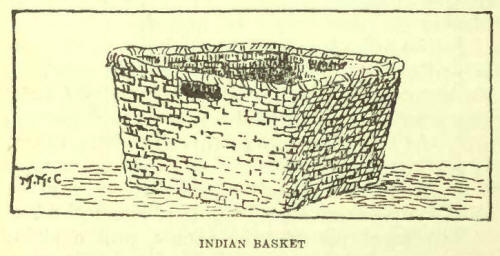
This talk led up to tales
of early marriages among the whites. Mr. Hewson's father was a
magistrate and as such was authorized to perform the marriage ceremony.
His field covered the whole country from Holland Landing to Penetang.
"One of the first marriage ceremonies performed by my father was when he
declared his neighbour David Soules legally wedded. Soules had gone to
Pickering for his bride, a Miss Yeomans, and the trip across Lake Simcoe
was made in a boat rowed by the prospective groom.
"The law required the posting of notices of intention to marry in three
prominent places for three weeks before marriage. A widower, a Quaker
about to remarry, put up one of his notices in the cleft of a tree,
hoping thereby to comply with the law while at the same time avoiding
publicity. It happened, however, that a search party, while hunting for
a man who had been lost in the bush, came across this notice and soon
made it public enough to comply with the most rigid of legal
requirements. One day, when father was away from home, a negro came to
our place to be married. When this man found father was away he wanted
my mother to act, on the ground that the Bible pronounced man and wife
one. He contended, therefore, that what one could do the other could
surely do as well. However, the colored man was told he would not only
have to wait until father returned but until notice could be given also.
Three weeks later, after legal notice had been given, when father went
to perform the ceremony, he found the couple already living together as
man and wife. One couple, far from either minister or magistrate, did
not have the ceremony performed in their case until one of their sons
was grown up.
"The first Methodist
minister in Innisfil township was Hardy by name, and he was hardy by
nature. His field was from 'Penetang' to 'The Landing'; he covered that
distance twice a week on foot and held nine services in the seven days.
"There were few better stands of pine in Ontario than that of Innisfil
when the first settlers came in. Near the site of the Twelfth Line
Church a man named Pratt had a particularly good lot of pine trees and
lie offered these, as they stood, at one cent per log to Robert
Thompson, who then had a mill at Painswick. But pine was worth so little
at the time that the offer was refused. When the old Northern Railway
was built, pine did begin to have a value, and quite an active lumbering
industry sprang
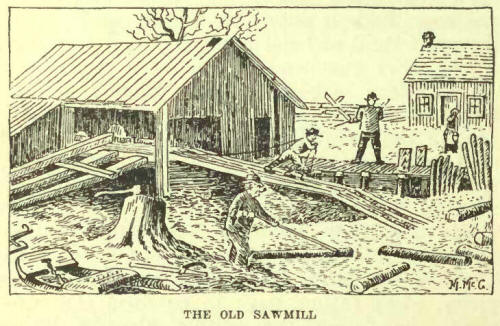
up in the township. Sage
and Grant, who introduced bob-sleighs into Innisfil, had a mill at Belle
Ewart that at one time employed seventy men. Mills were also established
at `The Point', Tollendale, Craigvale, the Seventh Line, Gilford and
Lakeland. At Lakeland, iii addition to the mill, there was at dock,
hotel, store, and a really attractive group of homes with locusts
ornamenting the front yards."
But all these mills have
disappeared long since. and Lakel<aiid and Belle Ewart, would be mere
sand beaches to-day had it not been for the development of the Lake
Simcoe ice trade in winter and tourist traffic in summer.
At the time that Mr.
Hewson related to me his stories of the days when Lake Simcoe was an
important link in a great highway between north and south I obtained
from Dr. B. Paterson, then of Barrie, some further particulars regarding
the beginning of the Toronto Penetang route. According to Dr. Paterson
the journey between these two places was at times made by an entirely
overland route as early as 1814.
"At that time," Dr.
Paterson said, "my father had a contract for transporting supplies from
Toronto for the garrison of two hundred men at Penetang'. The entire
journey was made by an overland route, passing to the westward of the
bay at Barrie. Over part of that route, however, axes had to be carried
to cut trees out of the way, and the trip occupied two weeks. Holland
River was crossed on a floating bridge, and frequently, on returning to
the river, it would be found that the bridge had been carried away, and
it was then necessary to build a new one. The only house between
Penetang' and 'The Landing' at that time was a hewed log affair at Crown
Hill.'
By Andrew Wallace, one of
the pioneers of Innisfil, I was given some further particulars about.
the Lakeland milling enterprise. "A man named Vance invested thirty
thousand dollars in that venture," Mr. Wallace said. "The mill did not
run very long and some years later, when the property had fallen into
decay, Vance visited the scene of desolation. As he was standing on the
wreck of the wharf looking into the water below some one asked him what
was interesting him. "I am trying to discover where my thirty thousand
dollars went," was the reply.
RAFTING TIMBER ON THE ST.
LAWRENCE
The family history of Mr.
Henry Smith of Barrie, another descendant of the Simcoe pioneers, is
remarkable for its variety of colour. The name was originally Schmidt,
and the first of the name in America was Heinrich Schmidt, an officer in
the Hessian troops sent over by George III at the time of the American
Revolutionary War. This Heinrich was the grandfather of Henry Smith,
whose story follows:
"The troop-ship, on which
my grandfather sailed to America, was eighteen weeks in crossing from
Germany," said Mr. Smith. "So long was the voyage, that the officer in
command of the troops asked the admiral of the fleet if he was quite
sure that he had not passed America in the night. When my maternal
grandmother, who was also with the troops, caught sight of a field of
corn after landing, she exclaimed: `America must, indeed, be a rich
country when there are so many ribbons here.' She mistook the leaves of
the ripening corn, glistening in the evening sun. for ribbons hung out
to dry.
"After the Revolution my
grandfather received a grant of land in the township of Marysburg,
Prince Edward County, and that is how Smith's Bay obtained its name. A
man called Snider, who had a rather notable nose, settled on a prominent
point in the same township and hence the name, locally applied, of
Snider's Nose."
Mr. Smith's own life was
about as varied and full of adventure as that of his grandfather. As a
lad of fourteen he assisted in rafting timber down the St. Lawrence.
"More than once, in going through the big chute at the
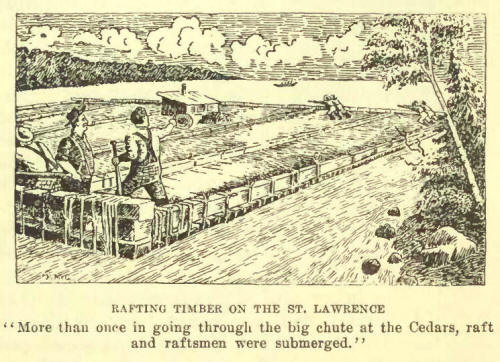
Cedars, raft and raftsmen
were submerged in the waves, and it was then a case of sit tight or stay
under," said Mr. Smith. "Some of the timber forming the rafts came from
Prince Edward County, but more of it came down the Trent. Oak and pine
logs were rafted together, the latter helping to keep the former afloat.
A good deal of the timber was for spars. You can judge the length of
some of this spar timber, when I tell you that I have seen five, six,
and even seven saw-logs cut from one tree. The record spar, which was
one hundred and twenty feet long, came from Big Bay Point on Lake Simcoe.
Eight or ten teams were used in hauling such timbers from the bush to
the water's edge. When the rafts arrived at Montreal they were broken up
and loaded into sailing vessels for shipment to England. Those timber
vessels had large port-holes in their bows, and the timber was hauled to
these holes by horses operating a windlass and then shot into the hold.
When the timber fleet was in Montreal harbour the masts appeared like a
great forest from which the limbs had been stripped. As I went down the
river on rafts I often met immigrants coming up in bateaux or Durham
boats. These vessels were much alike save that the bateaux were open
while the Durhams were partially decked over. Men, women, and children
were huddled together in these craft by day and camped on shore at
night.
"All the lakes and rivers
were then full of fish. I helped haul in a net near Willard's Beach in
Prince Edward County that contained fourteen thousand fish, and I have
seen salmon near there that were eight inches through the body. In one
case a salmon actually broke the handle of the spear and got away, but
was afterwards caught with the fragment still in its body."
In 1847, Mr. Smith moved
to Vespra, north of Barrie. The journey from Toronto to Holland Landing
was by stage. "Near the end of the journey," said Mrs. Smith, "the
driver, who was drunk, lost control of the horses on the down grade of
one of the hills. The body of the stage pitched from side to side,
forward and back, the passengers meantime holding on to anything within
reach. It is a wonder our necks were not broken.
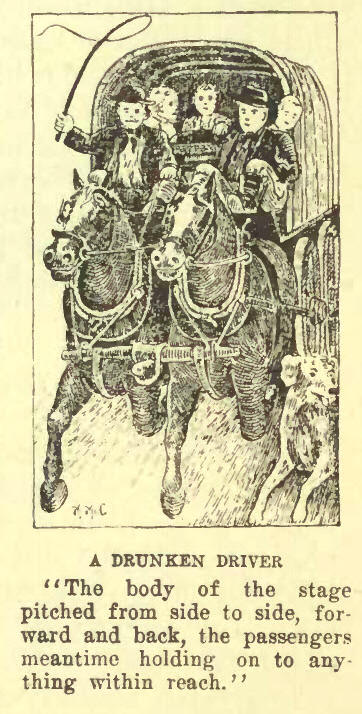
"From the `Landing' to
Barrie passage was taken by the steamer Beaver the remains of which are
now buried beneath the foundation of the local Grand Trunk Station. From
Barrie we followed the old Sunnidale or Nine Mile Portage Road to Willow
Creek."
I am indebted to Mr. A.
F. Hunter for the history of this old highway, which dates back to 1814,
and was built in the first place as a military highway. Early in the War
of 1812-15 a British force had captured the fort on Mackinac Island.
Later on the Americans prepared for its recapture. in order to reinforce
the Brit -ish garrison a force was despatched from Kingston in February,
1814. This force marched overland via Toronto to Holland Landing and
thence over the ice of Lake Simcoe to Barrie.
Front Barrie the Nine
Mile Portage Road was cut through to Willow Creek. There, trees, cut
from the surrounding forest, were fashioned into bateaux, and in these
improvised craft, when spring came, the relieving force floated down
Willow Creek to the Nottawasaga River, along that river to Georgian Bay,
and thence to Mackinac. Block-houses as bases of supply were built at
1-lolland Landing, Barrie, and Willow Creek; the Barrie block-house
being located where the music hall now stands. Willow Creek was quite an
important centre of settlement for years afterwards, but to-day not one
stone remains upon another. Only a few holes mark the site, these holes
having been dug in search of gold which tradition said had been buried
there.
A WAYSIDE INN'S FAMOUS
GUESTS
There is possibly no
other Ontario farm with the exception of farms along the lake frontier,
which is so prominently connected with local history as is the old
Warnica homestead,—lot thirteen on the twelfth of Innisfil,—opposite the
beautiful avenue of pines on the Penetang' Road, two miles south of
Barrie.
The farm was given to
John Stamm for his services with Button's Cavalry in the War of 1812-15,
and settlement duties on the place were begun by Stamm. Once, when on
his way to the place from Markham township, Stamm narrowly escaped
drowning in Lake Simcoe. That was enough of that location for him, and
he sold his place to the first of the Canadian Warnicas for ten dollars.
The Warnicas took possession in 1825. Shortly afterwards, because of the
growiug t raffle between north and south, the house on the place became
an mu; and, although there were only two rooms and a loft available for
travellers, some distinguished guests were entertained there. It is said
that Sir John Franklin spent a night at the inn on his overland trip to
the Arctic regions, and a voyageur sent back by Sir John sought shelter
at the same place on the return journey. Bishop Strachan, on journeys
north and south, made this a stopping place; and Sir John Colborne, when
Governor of Upper Canada, was provided with food and lodging there when
on his tour of inspection of the military post at Penetang'. So well
pleased was Sir John with the accommodation provided that he offered
each of the Warnica boys a free grant bush lot. How little such lots
were valued at the time is evidenced by the fact that the boys did not
think it worth while to go to Toronto to secure the deeds of the
property tendered them.
When the Warnicas first
settled in Innisfil, Lake Simcoe was still a connecting link on the
Toronto-Penetang' highway, and Big Bay point was located right on that
highway. David Soules, one of the first settlers on `The Point', told
Warnica he was a fool to settle so far to the west. "You will be away
off the main road," said Soules, "and the blackbirds will eat all your
crops." To-day, however, it is `The Point' that is isolated while the
old Warnica farm fronts on one of the principal provincial highways.
At the beginning the
Warnicas endured many privations. Clothing was largely made of homegrown
flax, and one of the IVarniea boys of that day had to stay in bed while
his one linen shirt was being washed.
The first grist from the
Warnica farm had to be hauled to the old "Red Mill" at Holland Landing.
Once when a grist was being taken it was intended to make the round trip
in a day, but the men were storm-stayed at Grassi Point on the return
journey. The night, however, was spent in comparative comfort, as
Indians who were camping there at the time supplied the Warnica boys
with blankets.
Running all through these
old-time sketches incidents are related in which the first settlers were
indebted to the Indians for kindness such as that shown the Warnicas.
The conduct of the aborigines stands all the more to their credit when
the manner in which they were being plundered and brutalized by white
traders is borne in mind.
Slowly but surely times
changed for the better. The settlement along the Penetang' Road north of
Barrie, producing beyond local needs, demanded a route all the way to
Toronto, and money was raised, apparently by public subscription, to
build around Barrie Bay a link to connect the old Penetang' Road north
of Barnie with the line north from Holland Landing. Two of the Warnica
boys were given the eon- tract of cutting out the bush from Tollendale
to Churchill, a distance of eleven miles, at five dollars per mile. That
would seem very small pay to road-builders of to-day, but five dollars
went a long way when Innisfil was young. The hardest part of the
Warnicas' task was at Stroud, which, although dry enough now, was a
difficult swamp at that time.
Previous to this the
Warnicas had made considerable money in teaming military supplies
intended for the Penetang' garrison over the Nine Mile Portage Road
between Barrie and Willow Creek. Then, when settlement began to move
into the Sunnidale and Beaver valleys, they obtained remunerative
employment in teaming the effects of the more northern settlers to their
destination.
The first of the Warnicas,
besides being a pioneer in the matter of settlement, was a participant
in the inauguration of municipal government in Innisfil. He, with
Charles Wilson and John Henry, formed the equivalent of the first local
council when Innisfil was municipally organized in 1841. He was also a
member of the Home District Council, which then met in Toronto. The
manner of election for it place in the latter body is an illustration of
the free and easy way in which elections were carried on in the early
days. Warnica and David Soules were contestants for the office and the
election was held at the old Myers tavern at Stroud. To decide the
matter it was arranged that one of the contestants should lead his
supporters south along the road from the tavern while the followers of
the other should be led north. The one that had the largest following,
and this was Warnica, was declared elected.
Some of the family
history of the Warnicas is as interesting as it that of the farm with
which the family name has been identified for a century. The first of
the family was a Dane, whose name was spelled Werneck. As a young man
Werneck possessed considerable means, which he spent largely in seeing
the world. On his return to Denmark, while telling of some of his
adventures, his word was questioned, whereupon Werneck promptly struck
down the
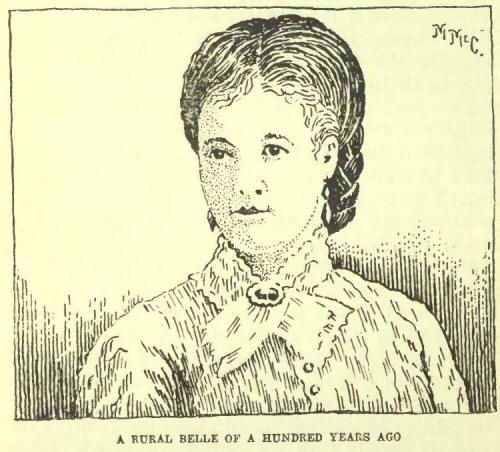
"Doubting Thomas." For
this he was fined forty kronen by a Danish magistrate. On paying the
fine Werneck asked if a second offence would cost the same, and was
assured it would. Another forty kronen pile was promptly counted out
with the first, and then Werneck knocked down the magistrate. At a much
later date, while playing the fiddle for a party in his Innisfil farm,
this fiery Dane had the misfortune to fall, and, when one of the party
asked if the fiddle had been broken, the fiddle was hurled at the head
of the questioner for making the first enquiry about the instrument
instead of for the life that might have been lost in the fall.
Some time after the forty
kronen incident Werneck sailed for New York, and there the family name
was changed to Warrick. On coming to Canada, at a still later date, the
"k" was changed to "a", and for three generations Warnica has been one
of the best known family names in the township of Innisfil.
While in New York State
Warnica married a German -widow named Myers. Mrs. Myers' parents, and
all of her grandparents with the exception of one grandmother, had been
killed and scalped during an Indian raid in the Mohawk Valley at the
time of the American Revolutionary War. The surviving grandmother had
been scalped and left for dead, but survived for years afterwards. Mrs.
Myers herself escaped the massacre because, as a babe, she was asleep
and was overlooked.
A combination of Danish
and German blood in the first of the family with subsequent
intermarriage amongst descendants of the English, Irish, and Scotch
pioneers of Innisfil, the Warnicas, like the old Hessian soldiers and
the descendants of the palatinates of Sunderland, furnish a striking
illustration of the varied nature of the strains entering into the
making of the Canadian commonwealth.
A. LONG WAY TO THE MILL
When I listened to the
story which follows, near the close of the last century, the country
between Barrie and Penetanguishene had long played its part in Canadian
history. Penetang' itself, like Toronto, figured in the War of 1812-15,
and the settlements between Barrie and Penetang' began almost as early
as settlements near Toronto. The Drury farm at Crown Hill, for example,
was taken up by the grandfather of the Honourable E. C. Drury in 1819,
and the Methodist Church at Dalston bears the dates 1827-97. At the same
time, not far from the road leading to Penetang,' pioneer conditions
still existed twenty-five years ago.
What is here related is
based mainly on what I was told by Thomas Craig, of Craighurst, who was
then living on the north half of lot forty-two on the first concession
of Medonte. Of that farm something could then be said that probably
could not be said of any other farm in Ontario. The lot was taken up a.s
a grant from the Crown by Mr. Craig's grandfather in 1821, and from that
time, until 1899, there was never a mortgage against the property, the
only records standing in connection therewith in the Registry Office at
Barrie being in the form of transfers from father to son.
"There were," said Mr.
Craig, "two reasons why grandfather located so far north. One was that.
the land about. Kernpenfeldt Bay was all in the hands of military
pensioners and that about Daiston in the hands of a company; the other
was that. the British garrison at Penetang' provided a convenient
market.
"Penetang' garrison was
maintained until about the middle of the century and was made up in part
of some of Wellington's veterans. One of these, Charles Collins, was in
the 52nd Regiment at Waterloo. John Hamilton was another Waterloo man.
Private McGinnis served in the Peninsular War and received his discharge
at Penetang.' He left a number of descendants in the country west of
Craighurst.
"As a boy," continued Mr.
Craig, "I saw parties of soldiers passing along the road on their way to
and from Penetang.' They travelled in small parties so as not to crowd
stopping places between Toronto and Georgian Bay. Once, when a party was
on the way north, the officer in charge swore that he would march his
men from Newmnarket to Penetang' in a. day. He did it, but two of the
men died by the wayside. One of these was literally done to death by
mosquitos and was buried near where Wye-bridge now stands.
"I have seen Indians,
hundreds and hundreds of them at a time, going along the same road on
their way to and from Toronto. In late fall they went south to make
baskets in the woods, then standing near Toronto, and to sell them in
the city. In early spring they returned to the Christian Islands to make
sugar, to fish, and later on to engage in the fall hunt. Although
drunkenness frequently occurred among the Indians, we did not fear them
as they never offered to molest the settlers."
Speaking of early,
experiences Mr. Craig went on: "Grists had to be carried all the way to
Newmarket, but the Government mill at Coldwater later on relieved us of
the necessity of snaking that journey. About 1830, Government and
settlers joined in erecting another mill at Tidhurst. For our groceries
we were still compelled to go to Newmarket, where the first of the
Cawthras then had a store. The road between here and Barrie was nothing
but a trail; from Barrie to Holland Landing we travelled on the ice in
winter and by boat in summer, and from Holland Landing to Newmarket by
Yonge Street. The round trip occupied three or four days. In the
beginning supplies were packed on the back, but later on two or three
joined in the use of an ox-team and jumper. Eventually F. C. Drury's
grandfather and my father ,joined in building a road around the bay at
Barrie, and then the entire journey could be made without crossing Lake
Simcoe.
"The first post-office
north of Newmarket was at Penetang'. There was a regular mail service
from Toronto to Newmarket, but mail for points further north was given
for delivery to the first reliable settler who happened to come along.
This volunteer carrier, the beginning of rural mail delivery,
distributed his letters as he passed up Yonge Street and time Penetang'
Road, and handed in the regular mail-bag for Penctang' when he reached
that point. Sometimes there were letters still in this bag for settlers
along the way, and these had to be sent back as chance offered."
The first wagon that
passed over this road was made in 1826 or 1827 by a man named White, of
Newmarket. It was built largely of Swedish iron and was still in
existence at the close of the last century.
HARDSHIPS OF THE
NOTTAWASAGA PIONEERS
As the country about
Creemore, in Nottawasaga, was settled at an earlier date than was Flos,
the hardships of the Nottawasaga pioneers were greater than those
sustained by the Flos pioneers.
One of the early settlers
in Nottawasaga was Joseph Galloway, who located near Creemore in 1852.
Some twenty years before that time, Mr. Galloway's father, who was then
living near Bradford, teamed flour into the northern township with oxen.
"That flour," said Mr. Joseph Galloway, "was sold to the settlers at
eight or ten dollars per barrel; but it was worth the cost as a week was
taken on the round trip, and over a great part of the way the country
was solid bush. Tt was dear flour to the settlers all the same, as some
of those who purchased it had earned the necessary money by working in
the harvest fields at `tile front' at fifty cents per day. Some were
unable to pay the price and, on one occasion, one mail weilt without
bread for nearly two weeks.
"Even when I moved into
the township one-third of the lots for the last fourteen miles of the
way had not a tree cut on them, and the others had but small clearings.
Deer were more plentifill then than sheep are now. On the Currie farm,
just outside of Creemore, were `licks' to which deer came in droves. In
a nearby creek, now a
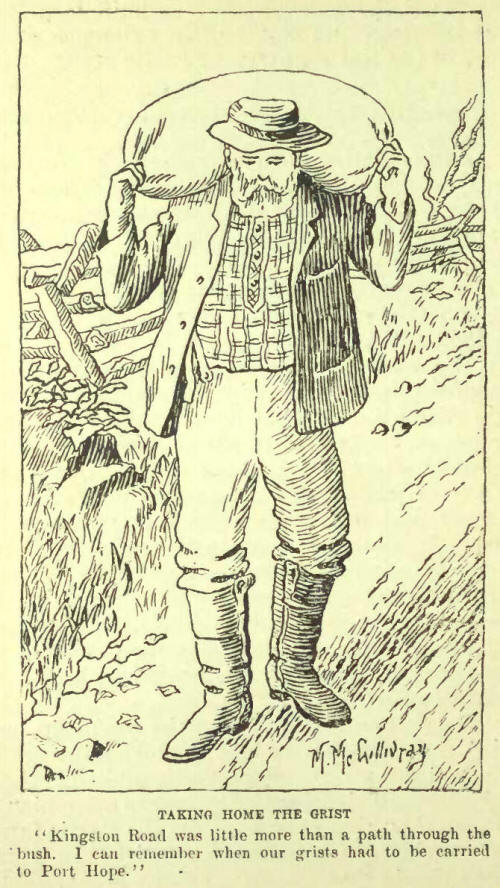
mere dribble, one could
catch a pailful of speckled trout in an hour. In one night wolves killed
fourteen sheep.
"We had the choice of
four markets—Barrie, Bradford, Holland Landing, and Newmarket. To reach
Barrie, the nearest of the four, involved a journey covering two whole
days and part of the nights. Our usual practice was to leave before
three in the morning, and if we got back at midnight of the second day
we considered ourselves lucky. Twenty-five to thirty
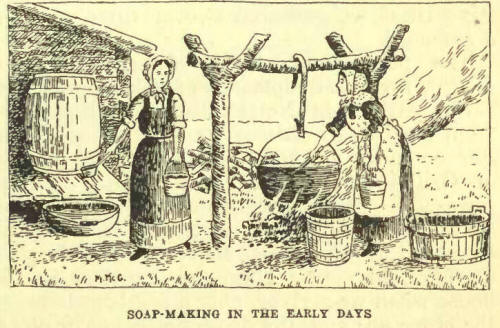
bushels made a load of
wheat. The price was fifty cents per bushel, and half trade at that. A
yoke of oxen, weighing over a ton each, sold in Toronto for sixty-five
dollars. A change came with the extension of the old Northern Railway to
Collingwood and with the Crimean War. In the fall of 1854 I sold wheat
for fifty cents at Bradford; the next year I got one dollar and a half
at Stayner. "It was plain living in the early days. Our log house was
eighteen feet wide by twenty-four feet deep, and eleven logs high. There
was a stone fireplace and chimney at one end, and to reach the upper
rooms a ladder was used instead of stairs. Bread was baked in a pot that
would hold half a pail of dough and the baking was done by putting the
pot in a pail of ashes on the hearth. We had a frying-pan with a long
handle in which we cooked venison and trout, the pan being placed on the
coals in the fireplace. There were wild plum trees about a mile away,
and from these we gathered two or three pails in a season."
The parents of Archie
Currie, formerly M.P.P. for West Simcoe, were also among the early
settlers in Nottawasaga, coming there from Mariposa. In moving they
crossed Lake Simcoe on the ice, and proceeded thence by way of Orillia
and Barrie to the sixth of Nottawasaga. "The clearing on the place to
which we moved was barely large enough to enable us to see the blue sky
above," Mr. Currie's mother told me. "There was no floor in the house
when we arrived, only a few boards to set the stove on; and, the doors
not being in place, we hung blankets over the openings to keep out the
winter wind. What is now Creemore was a network of tangled trees."
It was the practice of
the first settlers to go in parties when teaming their produce to Barrie
with ox-teams. There were no taverns by the roadside, and at dinner or
supper time a halt was made at a clearing. While the oxen ate their hay,
the men smoked their pipes and gossiped, an occasional drink of whiskey
causing the gossip to flow more freely. Sometimes a party would be
storm-bound in Barrie, and in that case a good deal of the scanty
receipts from the produce sold would be used up in paying for lodging.
In one instance a man was forced to send home for money to pay his way
back. In another case a settler, who had packed his load on his
shoulders, lost his way in the darkness on the road home. After vainly
groping about for some time he lay down with a pine knot for a pillow
and when he woke in the morning he found himself within a few rods of
his own door.
Nottawasaga was not, like
Flos, a prohibition township. In the former whiskey was as free as
water. It was a common practice at stores to keep a barrel on tap at
which customers were free to help themselves at will. One store at
Stayner continued this practice as late as the 'sixties and in
connection with that particular store and barrel a story is told of a
hoax perpetrated by a practical joker of the day. While the barrel was
free to all who came in, it was assumed that only such as were customers
would take advantage of the hospitality offered. There was one old chap
who seldom bought anything over the counter although he frequently drank
there and a young fellow decided to cure the old toper of the habit. So
when the thirsty one came in one day, and as usual began edging his way
to the open barrel, his attention was purposely diverted for a moment
and meantime the tin cup attached to the whiskey barrel was filled with
coal oil. The oil was taken at a gulp before the taste was noticed, but
it is probable that the weakness for free drinks was cured there and
then.
Tragedy was closely
linked with comedy in the drinking habits of pioneer days. A young -man
of eighteen, with Indian blood in his veins, was noted for his strength
and courage even in a community where these qualities were a
commonplace. He could lift a stone that a team of horses found it
difficult to move, and one of his feats was to stand on his head at the
pinnacle of a newly raised barn. He could, too, hold his own with the
hardest drinkers in carrying his load of liquor. But one day he overdid
it. He accepted a wager that he could drink a pailful at one sitting. He
swallowed the lot in three gulps, staggered to a fence corner and died.
THE RUGBY SETTLEMENT
Hardships quite as great
as those borne by most of the pioneers were endured by the first
settlers between Hawkstone and Rugby, on the west side of Lake Simcoe.
"When our people came
here in the early thirties," said Jolm Robertson, a son of one of the
Rugby pioneers, "they had to bring their flour all the way from Hog's
Hollow. The flour was teamed as far as Holland Landing and then carried
by boats, manned by Indians, to Hawk-stone. From Hawkstone the settlers
packed it on their backs to Rugby, a distance of six miles, and even to
Afedonte, six miles further on. The flour was usually carried in bags,
but on one occasion Grandfather George Robertson carTied home almost a
barrel of flour on his shoulders.
'In 1833, the Government
built a grist-mill at Coldwater. This was intended for the use of the
Indians, but it served settlers about Rugby as well. Being only fourteen
miles distant, it. proved a great convenience. Even at that, however,
two days were spent going and coming with grist. At times it took
longer, as not infrequently fifty teams would arrive at the mill in one
day, and then people had to wait their turn. While waiting, the men
cooked `chokedog', a mixture of flour and water, for their food. It was
as hard as a brick on the outside and soft as blubber in the middle."
Real comfort carne,
though, when, in 1855, a man named Dallas built a mill between Orillia
and where the Hospital for Feeble-Minded now stands. The stone
foundation for this mill was laid by the father of Duncan Anderson.
[Duncan was for years a popular Farmers' Institute lecturer and later
served three terms as mayor of Orillia.] While engaged in this
foundation work Mr. Anderson Sr., lived at home, three miles away. Still
he was always at work at the mill at seven, remained until six, and
after returning home he frequently worked in the logging field until ten
at night. The old Dallas mill disappeared long ago, but part of the
foundation still standing shows that the stones were well and truly
laid.
In the first year of the
Rugby settlement, before there was enough cleared ground on which to
grow potatoes, George Tudhope, formerly clerk of Oro Township, planted
some potatoes on shares at Holland Lauding. He pitted his share when
dug, and next spring moved them to Hawkstone by boat and from Hawkstone
carried them to Rugby on his back. One spring when potatoes were
exceptionally scarce, people actually dug up the tubers they had planted
for seed in order to secure food.
THE EARLY DAYS OF INNISFIL
"I have been here in
Innisfil longer than any man now living in the township. My memory
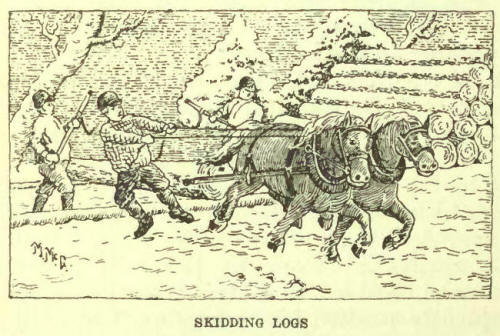
goes back to the time
long before the railway, when the forests, which then covered the land,
were filled with game and when Indians were as numerous around Lake
Simcoe as they still are about the north shore of Georgian Bay." It was
J. L. Warnica, then in his eightieth year, but who would have passed for
less than seventy, who made this statement. The story that followed
fully warranted the expectations aroused by the introduction. When Air.
Warnica was a young man, all the merchandise received in Barrie was
teamed there from Toronto, and much of the teaming was done by Mr.
Warnica himself. "When passing over `The Ridges' I have, from an
elevation, seen teams as far north and south as the eye could reach,"
said lair. Warnica. "It was like one huge funeral procession, and it was
made up of wagons from as far away as Medford and Penetang' on the
north, as well as wagons that had drifted in from intervening side
roads.
"The Innisfil teamsters
had two favourite stopping places in Toronto. One was the Fulljames
House, at the corner of Queen and Yonge streets, and the other was the
old Post tavern nearly opposite the St. Lawrence market. The Fulljames
place stood well back from the corner and covered practically the site
now occupied by the Eaton store. Great sheds for the accommodation of
teamsters filled the yards. The corner at that time marked the northern
limits of the city. The buildings in Toronto were scattered like those
of a village. The Queen Street asylum was two miles out of town. The
father of my first wife bought ten acres and an old tavern opposite the
main gate of the asylum for one thousand dollars.
"Yes, there were plenty
of taverns in those days," continued Mr. Warnica. "Between the head of
Kempenfeldt Bay at Barrie and Yonge Street wharf in Toronto, there were
sixty-eight licensed houses—one for each mile of the road and three to
spare, besides eight or ten unlicensed places. Distilleries were also
numerous. There was one at Tollendale, opposite Barrie, and another on
the creek that runs through Allandale. These were, however, soon snuffed
out and the bulk of the business in this line passed to the Gooderhams.
Most of my freight, when I was teaming, consisted of Gooderham whiskey.
Six barrels made a load and, after being hauled all the way to Barrie,
it retailed at twenty-five cents per gallon.
"But then the freight
bill was not very high," Mr. Warnica went on. "The regular charge for
teaming a load of whiskey to Barrie was eight dollars. Out of that the
teamster had to pay for the feed of his horses, board for himself, and
the fee at seven toll gates. I remember once, when another teamster and
myself had a miscellaneous lot of merchandise for a Barrie merchant, we
were charged with the loss of a box of ribbons. I do not believe we ever
received the box, but we had to pay for it all the same. On that
occasion, when expenses had been deducted, there was just seventy-five
cents to divide between us for the round trip. After that we preferred
to haul whiskey as there was no chance of loss on that.
"If freights were not
high, expenses incurred by freighters were not extravagant either.
Supper and bed for a man and hay for his team cost fifty cents at a
wayside tavern. It is true that it was not exactly royal fare. There
were three beds in each room and two people slept in each bed. There
were no stationary wash-stands, in fact, not so much as a washstand of
any kind. A basin stood in the bar and each man took his turn in going
out to the pump for a clean up.
"Some of these stopping
places were not too warm. I well remember one night spent at McLeod's
tavern, a little north of Aurora. The building was of frame and not
plastered at that. There were two thin cotton sheets and one quilt, and
a very thin one it was, on the bed. I had
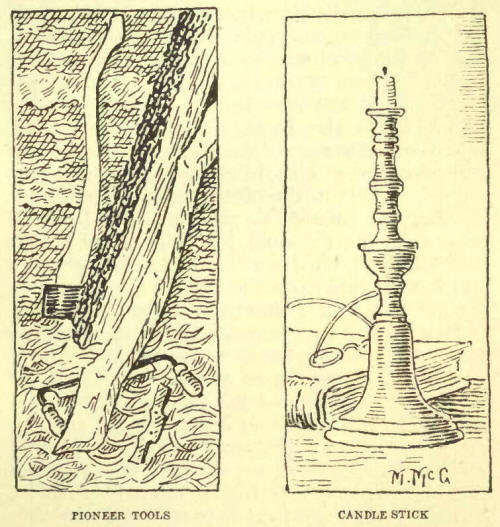
to rub my toes to keep
them from freezing in the night.
The accommodation north
of Barrie was poorer still. Once, early in March, father and I undertook
to move a camp of Indians from Tollendale to Rana. There was at that
time a tavern, known as The Half Way House, about midway between Barrie
and Orillia. We proposed to stop there for dinner, but the Highland
landlord informed us that he had no flour. `I have plenty of good
whiskey, though,' he said, evidently wondering what a man wanted to eat
for so long as he could get plenty to drink. Unable to get dinner we
decided to push on to Orillia. There we ordered dinner and supper in one
and took our Indian charges over to Rama while the meal was being
prepared. When we returned to the tavern I found, after unhitching, that
I could not get my horses into the only stable in the place as the door
was too low for the animals to pass in. The landlord proposed that I
should let them stand in the shed all night, but I was afraid that they
would perish with cold after the hard drive. So when supper was over I
started for home, where I arrived at five next morning, after having
been nearly twenty-four hours on the road.
"The roads, south as well
as north of our place, were as poor as the tavern accommodation. The low
places on Yonge Street and the Penetang' Road were covered with
corduroy, and as the logs were of uneven size you can imagine what it
was like driving over them. A little before my time a party of traders
on their way north to trade with the Indians reached Grassi. Point
toward evening. On their arrival one of the traders was taken ill, but
next day they went on to where the old Sixth Line Church now stands. The
man's condition became worse and that night he died. His body was buried
at the foot of a giant maple, which then stood just inside the present
cemetery grounds. From the tragic nature of the trader's death there
arose a story that the place was haunted, and a half-breed who then
carried the mail between Penetang' and Toronto quit his job because he
had to pass the place at night.
"I once had a bad fright,
there myself. I was on my way from 'Toronto, accompanied by my uncle in
another wagon, with a load of freight. We had been held up at Bradford
by a thunderstorm and when we reached the sixth line it was pitch dark.
A fire had been started by some men engaged during the day in improving
the road and this fire spread to the hollow stub, all that remained of
the big maple marking the grave of the trader. As I came near the spot I
beheld what seemed to be a light moving slowly up and down. I at once
thought of the spook story and my hair stood on end with fear. What I
really did see was a succession of fitful flames showing first at one
hole in the maple stub and then at another higher up or lower down. It
was all right when the explanation came but exceedingly uncomfortable
before learning the cause of the light.
"No, I was not born in
Innisfil," said Mr. Warnica as the conversation drifted off in another
direction. "I was born near Thornhill. My grandfather (Lyon) on my
mother's side established a grist-mill there before the time of Thorne,
after whom the place was named. A Pennsylvania Dutchman, Kover by name,
took a couple of stones from the creek and dressed them for grinding.
Before that we did our grinding in a coffee-mill we had brought with us.
Before that again people crushed wheat with the head of an axe in a hole
made in the top of an oak stump. This stump was on the third of Markham,
near Buttonville, and I remember quite well seeing the hole in it and
hearing the story. To my Grandfather Lyon was issued one of the first
two Crown deeds granted in Markham."
Turning once more to the
early days near Barrie, Mr. Warnica had something to say of Indian life
and the abundance of game that then filled the woods. "I have seen," he
said, "as many as one hundred Indian tepees in the woods about
Tollendale on the south side of Kempenfeldt Bay. It was an interesting
sight to watch the making of an Indian home in winter. The head of the
family, carrying bow and arrow, tomahawk and knife, strode ahead. The
mother, carrying one or two papooses on her back, as well as the
household belongings, followed. When the site selected for the camp was
reached, the Indian chopped down a few saplings with crotched tops. The
squaw meantime, with a cedar shovel, formed a circular hole in the snow.
The crotched sticks were set up around this and covered with bark or
evergreens; a fire was started in the middle of the tent, evergreen
boughs were spread on the ground and covered with fur, and, in half an
hour, the house was ready for occupation. While the work of preparation
was going on the papooses, strapped to flat hoards, were hung up on
trees by hooks at the heads of the boards. If one cried the mother would
stop work for a moment and soothe the child with a gentle rocking
accompanied by a lullaby.
"Game—bear, deer,
partridge, and pigeons—was more than abundant. I have killed partridges
with a club. I once struck down a pigeon with an ox-goad; another time,
with two shots—one fired into a flock of pigeons as they were feeding on
the ground and the other as they rose—I secured twenty-nine birds; I
have frequently brought down ten or a dozen at a single shot.
"As a boy, I have heard
the wolves howling in the woods at night, and in the morning the sweat
would pour from me with fear as I went into these same woods to hunt for
the cows. On one occasion I helped capture two young bears on the
Penetang' road opposite our place, a little south of Barrie. We cut down
the trees in which the animals had taken refuge and then killed them
with clubs.
"What became of the
pigeons? I do not know, but I have a theory. At theory is that all this
game was placed here for the use of man when no other form of food was
available and that it disappeared when the need for it no longer
existed.
"I have witnessed almost
all the changes that have taken place in Innisfil," said Mr. Warnica as
he concluded his story. "I was here at the beginning of the settlement,
and I was already a young man when the railway came. I bought my first
overcoat with money earned in making pick- and axe-handles, and cart
shafts, for use in the work of construction. I came here as an infant,
and the longest time I have spent away from home was when I put in
twenty-eight days at the World's Fair at Chicago. I was always
interested in fairs; I attended twenty-two out of twenty-four of the old
Provincials in the days when the fair was held alternately at London,
Kingston, and other places."
Mr. Warnica's first wife
was a niece of John Montgomery of Montgomery's Tavern and his second, a
niece by marriage of Samuel Lount, one of the martyrs of 'Thirty-Seven.
But Mr. Warnica himself was a mere child in the troubled times of the
'thirties and all he knew of the period before the rebellion was a mere
matter of hearsay. He told of one incident, however, that throws some
light on the conditions that helped to fan the flames of revolt.
"My uncle William," he
said, "was one of the first advocates of free schools and he once
broached the subject at a meeting at Barrie. `What do you need such
schools for?' stuttered one of the Family Compact champions. `There will
always be enough well educated Old Countrymen to transact all public
business, and we can leave Canadians to clean up the bush.' "
The sentiment thus
expressed is not wholly dead yet, although it exists in a somewhat
different form. There are still those who think they were made to ride
while others were made to he ridden.
REMINISCENCES OF A
SUNNIDALE PIONEER
One of the most
interesting and instructive accounts of pioneer life of Upper Canada
during the early part of the last century is contained in Reminiscences
of a Canadian Pioneer, by Samuel Thompson. Thompson was a man of some
education, having served a seven years' apprenticeship in London,
England, at the printing trade. He was a writer of ability and no mean
poet, and during his later years in Canada was an editor and publisher.
He remained but a short time in the bush, but the account of his
experiences throw much light on pioneer conditions.
A settler to reach Canada
from the British Isles had in nearly every case trying experiences.
Little thought was given to the comfort of the emigrants by the
transportation companies of those days, and the journey across the
Atlantic was not the least of the trials the early settlers had to
endure. Thompson's case was no exception. He and his two brothers,
Thomas and Isaac, sailed from London in the spring of 1833 in the Asia
of 500 tons, a large ship for those days. Buffeted by head winds, the
Asia spent a fortnight in the English Channel, but, a favourable breeze
springing up, they made an excellent run until the banks of Newfoundland
was reached, when it seemed that their voyage was about ended. Here they
encountered a furious storm, against which the Asia could make no
progress. To make matters worse, the vessel sprang a leak, the ballast
shifted, and. lying at an angle of fifteen degrees, she wallowed in the
tumbling waves. Crew and passengers manned the pumps continuously, but
still the water gained on them. The captain discovered that the leak was
in such a position that when running before the wind it -would be out of
water, and so to save his ship he turned about and made for the Irish
coast and succeeded in reaching Galway Bay. Here the damage was
repaired, and with the addition of some wild Irish, Roman Catholics and
Orangemen, to her list of passengers the Asia once more headed
Canadawards. On the passage the vessel was almost wrecked, when passing
through a field of icebergs, "by the sudden break-down of a huge mass as
big as a cathedral."
When Quebec was reached,
the passengers of the Asia were transferred to a fine steamer for
Montreal. At Lachine, bateaux were provided to carry them up the St.
Lawrence. While at Lachine they had a picturesque reminder of the
vastness . of the land in which they were about. to make their homes.
"While loading up," says
Thompson, "we were favoured with one of those accidental `bits' —as a
painter would say—which occur so rarely in a life-time. The then despot
of the North-West, Sir George Simpson, was just starting for the seat of
his government via the Ottawa River. With him were some half-dozen
officers, civil and military, and the party was escorted by six or eight
Nor'-West canoes—each thirty or forty feet long, manned by some
twenty-four Indians, in the full glory of war-paint, feathers, and most
dazzling costumes. To see these stately boats, with their no less
stately crews, gliding with measured stroke, in gallant procession, on
their way to the vasty wilderness of the Hudson's Bay territory, with
the British flag displayed at each prow, was a sight never to be
forgotten."
It is unnecessary to
detail the Thompsons' westward voyage, similar to that of other settlers
already described in this book. Sufficient to say that they reached
Little York on the steamer United Kingdom during the first week in
September, 1833, four months after leaving London. "Muddy Little York,"
as it was not undeservedly called, had then a population of about 8,500.
According to Thompson, "in addition to King street the principal
thoroughfares were Lot, Hospital, and Newgate Streets, now more
euphoniously styled Queen, Richmond, and Adelaide Streets respectively."
Where the Prince George Hotel now stands was "a wheat-field." "So well,"
writes Thompson, "did the town merit its muddy soubriquet, that in
crossing Church Street near St. James' church, boots were drawn off the
feet by the tough clay soil; and to reach our tavern on Market Lane (now
Colborne Street), we had to hop from stone to stone placed loosely along
the roadside. There was rude flagged pavement here and there, but not a
solitary planked footpath throughout the town."
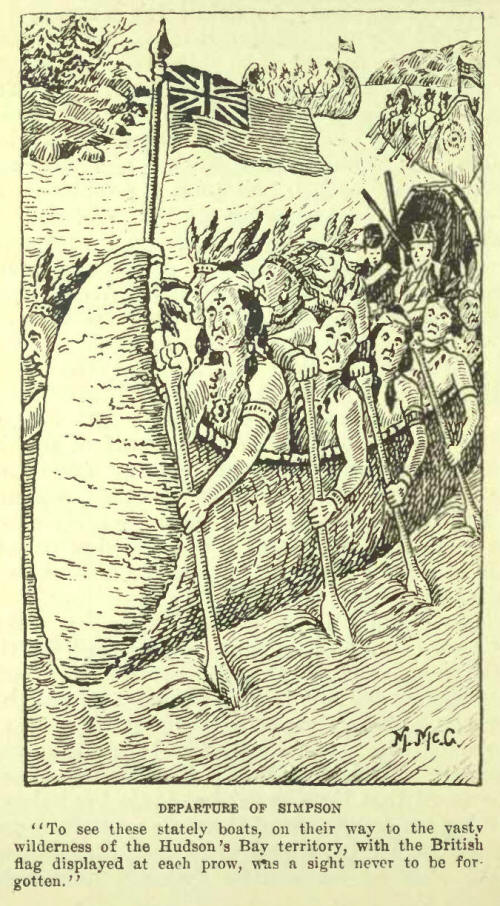
The Thompsons purchased a
location ticket for twenty pounds sterling, and set out for the Lake
Simcoe district "in an open wagon without springs, loaded with the
bedding and cooking utensils of intending settlers." After a day's
journey, they reached Holland Landing and from there crossed to Barrie
in a small steamer. Barrie, at that time, consisted of "a log bakery,
two log taverns,—one of them also a store,—and a farm-house, likewise
log. Other farm-houses there were at some little distance hidden by
trees." So desolate was the prospect that some members of the party
turned back, but the Thompsons pressed on "for the unknown forest, then
reaching, unbroken, from Lake Simcoe to Lake Huron." To the Nottawasaga
river, eleven miles, "a road had been chopped and logged sixty-six feet
wide; beyond the river nothing but a bush path existed."
They toiled on until
nightfall, covering a distance of eight miles and at a clearing in the
forest came on a bush tavern, "a log building of a single apartment."
"The floor," writes Thompson, "was of loose split logs, hewn into some
approach to evenness with an adze; the walls of logs entire, filled in
the interstices with chips of pine, which, however, did not prevent an
occasional glimpse of the objects visible outside, and had the
advantage, moreover, of rendering a window unnecessary; the hearth was
the bare soil, the ceiling slabs of pine wood, the chimney a square hole
in the roof; the fire was literally an entire tree, branches and all,
cut into four-feet lengths, and heaped up to the height of as many
feet." As the dancing flames lit up the apartment, they revealed "a log
bedstead in the darkest corner, a small red-framed looking-glass, a
clumsy comb suspended from a nail by a string,. . . stools of various
sizes and heights, on three legs or on four, or mere pieces of log sawn
short off." The tavern was kept by a Vermonter, named Dudley Root, and
his wife, "a smart, plump, good-looking little Irish woman." The pair
evidently knew how to cater for the occasional guests, as the breakfast
provided for the Thompsons proved,—` `fine dry potatoes, roast wild
pigeon, fried pork, cakes, butter, eggs, milk, `China tea,' and
chocolate—which last (declined by the Thompsons) was a brown-coloured
extract of cherry-tree bark, sassafras root, and wild sarsaparilla."
On through the forest
they trudged looking about for a favourable location, and finally
selected a hard-wood lot in the centre of the township of Sunnidale.
Here, with the help of a hired, expert axe-man, they soon had half an
acre cleared of its "splendid maples and beeches
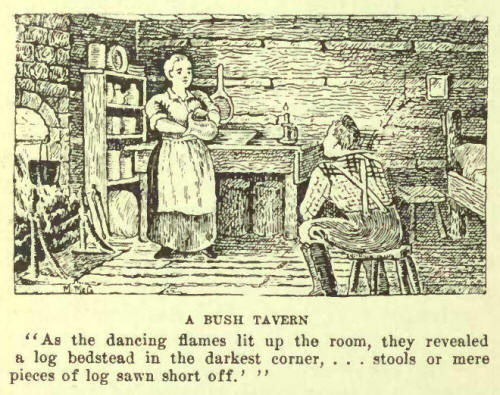
which it seemed almost a
profanation to destroy." In quick order they erected a log shanty,
twenty-five feet long and eighteen wide, "roofed with wooden troughs and
`chinked' with slats and moss .... At one end an open fire-place at the
other sumptuous beds laid on flatted logs, cushioned with soft hemlock
twigs, redolent of turpentine and health."
Thompson gives an
interesting account of the method of clearing the land, and in this
connection points out that in the Sunnidale district some of the young
women were almost as expert with the axe as the men. One of these,
Nary—, "daughter of an emigrant from the county of Galway ... became in
time a 'firstrate' chopper,
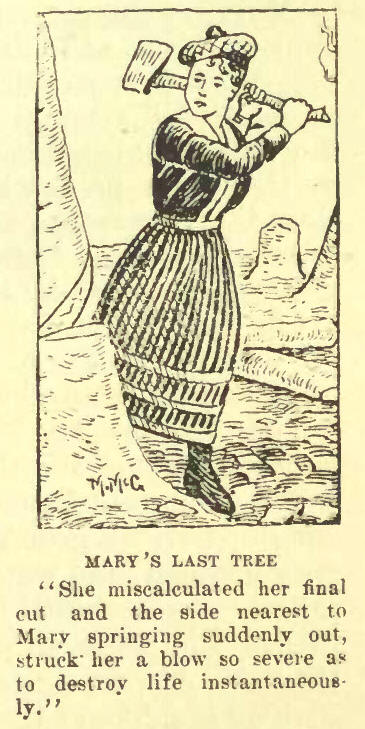
and would yield to none
of the new settlers in the dexterity with which she would fell, brush,
and cut up maple or beech." She and her elder sister, "neither of them
older than eighteen, would start before day-break to the nearest store,
seventeen miles off, and return the same evening laden each with a full
sack flung across the shoulder, containing about a bushel and a half, or
ninety pounds weight of potatoes." One of Mary's neighbours a young lad,
Johnny, a son of one of the earl- Scotch settlers in the Newcastle
district, who was about her own age, was a famous axe-man. Mary was
anxious to try her skill with the young Scot and got her brother, Patsy,
who was Johnny's working-mate, to vacate his place for her. She proved
herself quite as skillful as Johnny, and, it would seem, lost her heart
to him. The sequel shows to what perils the women of Ontario were
subjected in pioneer days. One day Mary was felling a huge yellow birch.
As she neared the end of her work, her mind seemed to wander from her
task and "she miscalculated her final cut and the birch, overbalancing,
split upwards, and the side nearest to Mary, springing suddenly out,
struck her a blow so severe as to destroy life instantaneously .... In a
decent coffin, contrived after many unsuccessful attempts by Johnny and
Patsy, the unfortunate girl was carried to her grave, in the same field
which she had assisted to clear." Thompson adds: "Many years have rolled
away since I stood by Mary's fresh-made grave, and it may be that Johnny
has forgotten his first love; but I was told, that no other has yet
taken the place of her, whom he once hoped to make his `bonny bride.' "
The Thompsons had some
heart-breaking experiences. "We lead," writes Thompson, "'with infinite
labour managed to clear off a small patch of ground, which we sowed with
spring wheat, and watched its growth with most intense anxiety until it
attained a height of ten inches, and began to put forth tender ears ...
. But one day in August, occurred a hailstorm such as is seldom
experienced in half a century. A perfect cataract of ice fell upon our
hapless wheat crop. Flattened hailstones, measuring two and a half
inches in diameter and seven and a half in circumference, covered the
ground several inches deep. Every blade of wheat was utterly destroyed,
and with it all our hopes of plenty for that year."
One of the worst pests
the early settlers had to contend with was the wild pigeons, a bird
that, so far as is known, is now extinct. These swept down on the land
in myriads and grain and pea fields were stripped clean by them. In
several other cases in this book these birds have been referred to, but
Thompson's account of them is most interesting. There was a pigeon-roost
a few miles distant from where he and his brothers had settled. To this
roost at the proper season "men, women, and children went by the
hundred, some with guns, but the majority with baskets, to pick up the
countless birds that had been disabled by the fall of great branches
broken off by the weight of their roosting comrades overhead. The women
skinned the birds, cut off the plump breasts, throwing the remainder
away, and packed them in barrels with salt, for keeping."
Thompson points out that
these pigeons were an important factor in connection with the vegetation
of these early days. He noticed that when land had been burnt over it
was almost immediately followed by "a spontaneous growth, first of
fireweed or wild lettuce, and secondly by a crop of young cherry trees,
so thick as to choke one another. At other spots, where pine trees had
stood for a century, the outcome of their destruction by fire was
invariably a thick growth of raspberries, with poplars of the aspen
variety." Thompson was not content with merely observing this seemingly
miraculous growth of new vegetation, he investigated the matter. ``I
scooped up," he writes, ``a panful of black soil from our clearing,
washed it, and got a small tea-cupful of cherry stones, exactly similar
to those growing in the forest." He naturally concluded that the pigeons
were responsible for the strange growth of cherry and raspberry in the
burnt, lands.
Becoming dissatisfied
with their Sunuidale lot, the Thompsons exchanged it for one in
Nottawasaga in the settlement called the Scotch line, where dwelt
Campbells, McGillivrays, McDiarmids, etc., very few of whom were able to
speak a word of English. Their life here was similar to that of other
settlers whose stories have already been told. One incident is worthy of
record as it shows the primitive condition of things in a community only
thirty-four miles from Barrie. Flora McAlmon, the wife of Malcolm
McAlmon, the most popular woman in the Scotch line settlement, died in
childbirth, largely due to the fact that no skilled physician or
experienced midwife was at hand. Her brother came to the Thompsons to
borrow pine boards to make a coffin. Excepting for some pine they had
cut down and sawn up, "there was not," says Thompson, "a foot of sawn
lumber in the settlement, and scarcely a hammer or a nail either, but
what we possessed ourselves. So, being very sorry for their affliction,
I told them they should have the coffin by next morning; and I set to
work myself, made a tolerably handsome bow, stained in black, of the
right shape and dimensions, and gave it to them at the appointed hour."
And in this rude coffin the weeping bearers bore the remains of fair
Flora McAlmon "through tangled brushwood and round upturned roots and
cradle-holes ... to the chosen grave in the wilderness where now, I
hear, stands a small Presbyterian Church in the village of Duntroon."
On several occasions
Samuel Thompson had walked to Toronto, a distance of ninety miles. In
1834, before leaving Sunnidale, he made his first trip, "equipped only
with an umbrella and a blue bag, . .. containing some articles of
clothing." The first part of his way was over a road strewn with logs
over which he had to jump every few feet. Rain came on, and as night
approached he found himself far from any human habitation. He returned
to "a newly-chopped and partially-logged clearing" he had passed on the
way. Here he found a small log hut in which the axe-men, who had been at
work, had left some fire. He "collected the half-consumed brands from
the still blazing log-heaps, to keep some warmth during the night, and
then lay down on the round logs in the hope of wooing sleep."
"But," he adds, "this was
not to be. At about nine o'clock there arose in the woods, first a sharp
snapping bark, answered by a single yelp; then two or three at
intervals. Again a silence, lasting perhaps five minutes. This kept on,
the noise increasing in frequency, and coming nearer and again nearer,
until it became impossible to mistake it for aught but the howling of
wolves. The clearing might be five or six acres. Scattered over it were
partially or wholly burnt log-heaps. I knew that wolves would not be
likely to venture among the fires, and that I was practically safe ....
I, however, kept, up my fire very assiduously, and the evil brutes
continued their concert of fiendish discords ... for many, many long
hours, until the glad beams of morning peeped through the trees; when
the wolves ceased their serenade, and I fell fast asleep, with my damp
umbrella for a pillow."
When he awoke, he
continued his journey to Bradford, where he was hospitably entertained
by Mr. Thomas Drury, and given a. letter of introduction to a man of
whom he "had occasionally heard in the bush, one William Lyon
Mackenzie." The remainder of his journey was "accomplished by stage—an
old-fashioned conveyance enough, swung on leather straps, and subject to
tremendous jerks from loose stones on the rough road, innocent of
Macadam, and full of the deepest ruts."
When the Thompsons left
London for Canada, they were sanguine "of returning in the course of six
or seven years, with plenty of money to enrich," and perhaps bring back
with them, their mother and unmarried sisters. In the meantime the
sisters came to Canada and found life on the bush farm totally unsuited
to their tastes. The brothers, too, were far from satisfied. Their
holding promised them only years of unremitting toil, with but a small
return. They saw other opportunities and so disposed of their property,
Thomas and Isaac moving with their sisters to a rented farm at Bradford
and Samuel going to Toronto, where he was long to play an active part in
the business and intellectual life of the community. |

